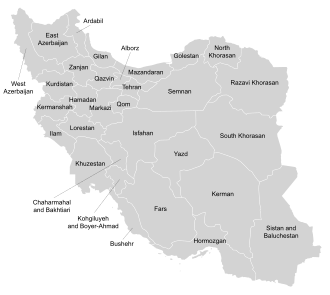Provinces of Iran
Provinces of Iran are the primary administrative divisions within the Islamic Republic of Iran, numbering 31 in total. Each province is governed by an appointed governor from the Ministry of Interior, reflecting the centralized nature of governance in Iran. The provinces are further subdivided into counties, districts, and rural districts, with cities serving as local administrative centers.
History
The history of Iran's administrative divisions has evolved through several stages, from the ancient satrapies of the Achaemenid Empire to the modern provinces shaped by historical, geographical, and political changes over centuries. The current provincial division system was largely established in the 20th century, with periodic adjustments reflecting population growth, administrative efficiency, and socio-political developments.
Geography
Iran's provinces cover a vast and diverse geographical landscape, from mountainous regions in the north, such as Gilan Province and Mazandaran Province, to arid and desert areas in the center and east, like Kerman Province and Sistan and Baluchestan Province. The country's strategic location and varied terrain have significant implications for climate, economy, and culture across provinces.
Economy
The economy of each province in Iran is shaped by its natural resources, geography, and historical trade patterns. Provinces such as Khuzestan Province are rich in oil and gas reserves, playing a crucial role in Iran's economy. Others, like Fars Province and Isfahan Province, are known for agriculture, handicrafts, and tourism, reflecting a diverse economic base across the country.
Demographics
The demographic composition of Iran's provinces varies widely, with a mix of ethnic groups, languages, and cultural practices. Major cities like Tehran, the capital city located in Tehran Province, are melting pots of diversity, hosting migrants from across the country. Other provinces, such as Kurdistan Province and Azerbaijan, have distinct ethnic majorities, contributing to Iran's rich cultural tapestry.
Administration
The administrative structure of provinces in Iran is designed to centralize decision-making and governance. Each province is headed by a governor-general, appointed by the Minister of Interior with approval from the Council of Ministers. Local governments in counties, districts, and cities focus on implementing policies and providing services within their jurisdictions, under the oversight of provincial authorities.
Challenges and Developments
Provinces in Iran face various challenges, including economic disparities, environmental issues, and the need for infrastructure development. The government has initiated several projects aimed at addressing these challenges, promoting balanced regional development, and improving living standards across the country.
See Also
Transform your life with W8MD's budget GLP-1 injections from $125.
W8MD offers a medical weight loss program to lose weight in Philadelphia. Our physician-supervised medical weight loss provides:
- Most insurances accepted or discounted self-pay rates. We will obtain insurance prior authorizations if needed.
- Generic GLP1 weight loss injections from $125 for the starting dose.
- Also offer prescription weight loss medications including Phentermine, Qsymia, Diethylpropion, Contrave etc.
NYC weight loss doctor appointments
Start your NYC weight loss journey today at our NYC medical weight loss and Philadelphia medical weight loss clinics.
- Call 718-946-5500 to lose weight in NYC or for medical weight loss in Philadelphia 215-676-2334.
- Tags:NYC medical weight loss, Philadelphia lose weight Zepbound NYC, Budget GLP1 weight loss injections, Wegovy Philadelphia, Wegovy NYC, Philadelphia medical weight loss, Brookly weight loss and Wegovy NYC
|
WikiMD's Wellness Encyclopedia |
| Let Food Be Thy Medicine Medicine Thy Food - Hippocrates |
Medical Disclaimer: WikiMD is not a substitute for professional medical advice. The information on WikiMD is provided as an information resource only, may be incorrect, outdated or misleading, and is not to be used or relied on for any diagnostic or treatment purposes. Please consult your health care provider before making any healthcare decisions or for guidance about a specific medical condition. WikiMD expressly disclaims responsibility, and shall have no liability, for any damages, loss, injury, or liability whatsoever suffered as a result of your reliance on the information contained in this site. By visiting this site you agree to the foregoing terms and conditions, which may from time to time be changed or supplemented by WikiMD. If you do not agree to the foregoing terms and conditions, you should not enter or use this site. See full disclaimer.
Credits:Most images are courtesy of Wikimedia commons, and templates, categories Wikipedia, licensed under CC BY SA or similar.
Contributors: Prab R. Tumpati, MD

